Photo

Slow Couture a 2 ans aujourd'hui ! C’est une soirée particulière qu’il faut fêter. Est-ce que vous avez lu mes petits récits? Mon Blog parle de couture responsable, de coudre à main, de slow fashion du passé et au present, et il y a encore d’autres arguments et de nouvelles surprises à découvrir. Ecrivez-moi à ce propos. Bonne été et regardez le ciel: il y a une merveilleuse lune pleine mais aussi des étoiles en train de tomber...
0 notes
Text
Slow Couture and the Realm of History.
For the text in Italian translation, please click on the link.
For history enthusiasts fragments of historical legacy may survive through various extant portrayals and through the reinterpretation of its protagonists in the field of literature and visual arts. William Shakespeare wrote a number of plays that dramatized the lives of historical figures, but he combined reality and fantasy, by introducing fictional characters as well, like Sir John Falstaff. In the present time historical figures are also used as an instrument of sensibilization in order to give a greater impact to educative information. Art projects can bring history to life again if the topics do not a simply collect monographs but respect the social and political intertextuality, temporal and spatial continuity the historical figures are embedded in and the heritage they built.

Giving a practical example on the Italian territory, Design of the Universe has been producing a remarkable number of projects dedicated to historical facts and figures since 2012, with the objective to integrate the lessons of history into the present time and to take advantage of previous challenges. It does not mean the celebration of the past but a creative leap into the future by promoting events that focus on history and on its cultural and scientific evolution. Mostly generated in Italy, these projects frequently analyse women’s position in science, humanities, and arts, women who were marginalised and overshadowed by men through the centuries.

Three astronomers as the protagonists of three art&science projects produced by Design of the Universe on the occasion of their anniversaries: Henrietta Swan Leavitt (2021); Lucretia Caroline Herschel and Maria Mitchell (2018/19).
In the last ten years Elisabeth Vermeer, founder of the Atelier Design of the Universe, set up and accomplished numerous case-studies in the shape of pioneering interdisciplinary projects regarding women in the field of science and their difficult career path from the remote past to modern times. Up to now she has created a collection of female stories drawing inspiration from history, from different points of view and from different disciplines. Interdisciplinarity is the main feature of Design of the Universe, the way of creating something by thinking across boundaries. Thanks to accurate research it becomes quite clear that many scientists, both women and men, in the past and in the present, are very sensible to cultural issues, to art and architecture, music and poetry.
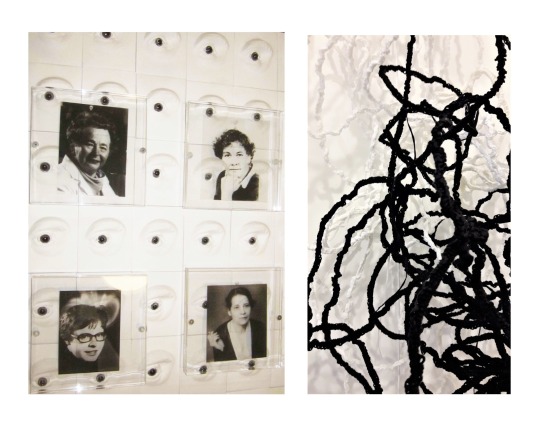
Gloria Pastore, Skies denied. Women scientists in different times. Site specific installation in plaster, obsidian stone and photos under plexiglass; Foundation Scienza e Tecnica, Florence; 2018.
Laura V.D.B.Facchini, Clouds. Site specific installation in Avantgarde materials and techniques at the Fortress of Montepulciano for the project “Late in the dream. A crossing of visions between astronomy and art”; 2018.
So it is not surprising at all that at a certain point Design of the Universe decides to set up a big project concentrated on women scientists on the occasion of the International Day of Women and Girls in Science which takes place every year on February 11th. The exhibition should have been presented last year but the waves of the pandemic rendered this mission impossible. The project entitled “Women in science, women of flowers” is now in program for next February 2023 in the Brera District of Milan. One of the personalities in the group of female scientists is an ingenious English lady, Ada Lovelace Byron, the only daughter of poet George Gordon Lord Byron and mathematician Anne Isabella Milbanke.

Little Ada with her parents.
Visionary and attracted by extremely complicated challenges like the mechanical and fanciful planning of flying steam machines, Ada Lovelace Byron represents first of all her belonging to different scientific and cultural universes, given her devotion to music, her predilection of the harp. In 1833, Mary Somerville, gifted British mathematician and Ada’s mentor, presented her to Charles Babbage,professor of mathematics at the University of Cambridge who, by that time, had already reached a remarkable reputation for his visionary and uncompleted projects on the behalf of giant calculators. Ada Lovelace Byron was one of the few persons to fully understand the ideas of Babbage and together they succeeded in creating a program for the analytical engine, anticipating the first computer, thanks to the imaginative force of the artist hidden in the systematical mind of the scientis

Charles Babbage, the Analytical Machine and Ada Lovelace Byron in a Daguerreotype by Antoine Claudet (1843), one of the two existent photos.
Connecting with the data of Ada’s life and work, however, an interesting question opens up which concerns the phenomenon of historicity oscillating between reality and fiction, facts and fancy. How did artists and poets approach the representation of Ada Lovelace Byron in her epoch and does this happen today? Let us have a look on the portraits made during her lifetime. Several artists tried to bring out the living likeness of Ada many times, and some of the most famous attempts, though good in and of themselves, always seem to adjust her features and to match certain epochal standards of beauty. There are numerous testimonies illustrating Ada Lovelace in different moments of her life.
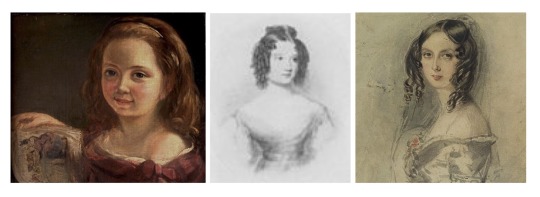
Ada as a child, at the age of seventeen and at the age of twenty (Carl H. Pforzheimer Collection at the New York Public Library)
The earliest witnesses are drawings and paintings when she was a child like the artwork by Comte Alfred d’Orsay, dated 1822 and actually held in the library of Somerville College, Oxford. Ten years later she was portrayed at the age of seventeen in a drawing by an unknown author. British painter Margaret Sarah Carpenter immortalized Ada on canvas in 1836, in a beautiful ivory dress with a gigot sleeve balanced by a tightly cinched waist, corresponding to the fashion dictate of the Twenties and Thirties. In London’s mundane high society she attracted attention for the extravagance of her mise and the elegance of her royal posture. In 1852, the year of her death, although in great pain, she agreed with Henry Phillips to sit for a painting seated at the piano, as her father, Lord Byron, had been painted by Phillips' father, Thomas Phillips.

On the background of her biographical notes a colorful prism of interpretations opens up in front of our eyes, deriving from different creative disciplines, not only to render the memory of such an impressive and unconventional personality like Ada more lively, but also to illustrate her social entourage in the Victorian epoch, culture and the difficult position of women in general, above all in the domain of science. All these contributions are available in the video-triptych on the You Tube Channel of Design of the Universe. A note regarding posthumous fame: Ada received an official appreciation only hundred fifty years later, when in 1979 the Ministry of Defense of the United States paid a tribute to her memory and to her work, assigning the name “Ada”, in a poetical spirit, to a programming language.

Without taking into consideration nowadays Avantgarde techniques which recreate historical personalities aided by software simulation and 3D interactive technology, Elisabeth Vermeer intuitively entrusts qualities like tradition, excellence, exclusive manual manufacture and eco-responsibility. These are the fundamental requisites in the field of Slow Couture. According to these premises, Ada Lovelace Byron was planned to come to life as a hybrid installation in mixed media, half painted, half sown by hand and completed with vegetal elements. This decision gave birth to an innovative concept design of how to represent historical figures in the context of their connection with nature, later on featured by Elisabeth Vermeer with the brand name Fleurestunefleur, which aims at bridging the gap between culture and nature, between diverse worlds, intellectual, digital, virtual and vegetal, physical ones.
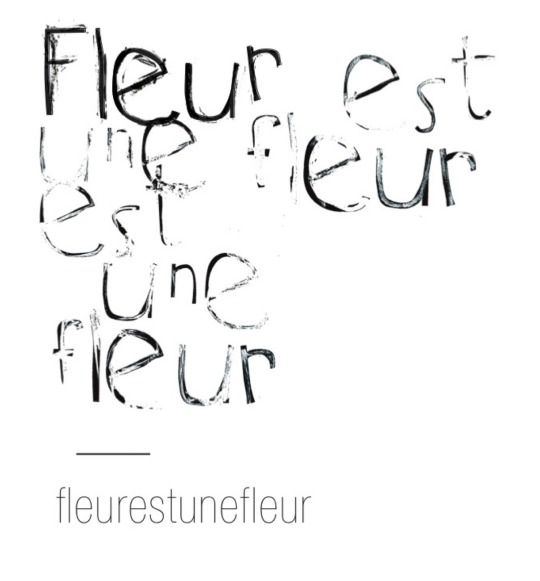
Logo of Elisabeth Vermeer’s brand Fleurestunefleur designed by Austrian artist Andreas Mares
This is the precise moment when Silvia Zambarbieri reentered the stage, in a very delicate and restrictive moment of pandemic, by proving her marvelous inventive force and productive velocity. While the curator had to cope with the lost chance of creating a scenography with a live-audience during the pandemic, Zambarbieri, the artisan-designer from Milan, imagined Ada Lovelace Byron in new clothes. Insisting on this collaboration, Elisabeth Vermeer made the right choice, as she knew perfectly well that Silvia Zambarbieri was really gifted with a dab hand at tailoring, though she also creates more fluid pieces celebrating the female forms for her everyday clients. Meanwhile the project had been necessarily reduced and transformed into a video triptych on line, artists, poets, musicians invited by Elisabeth Vermeer generated a kaleidoscopic mosaic consisting in fragments, photos, artworks, notes and digital compositions, thoughts and drawings.
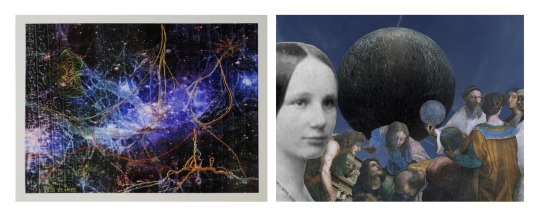
Uri De Beer and Carlo Accerboni, digital compositions and photo collage, 2020.
Their contributions meet altogether in a perspectival game, like mirrors which exist only in the reflection of one and another. The single parts constitute a strong value when these interact, like in the phantasmagoric world of quants, our meta-world.

Claire Jeanine Satin, Mario Pepe, Gian Luigi Suman: vintage computer installation and digital compositions, 2020.
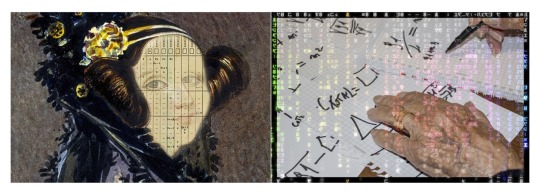
Gian Luigi Suman, Antonio Di Pace: digital composition and photography, 2020.

Dania Marchesi, Silvia Bibbo: digital compositions and painting in mixed media
As with most historical reconstructions, Silvia Zambarbieri (her brand name in fashion is D’Iside) did a lot of research but of course there is some percentage of imbued hypothetical data – especially when it comes to the color of Ada’s eyes and hair that determine the shape and structure of the face. Studying the variety of Ada’s portraits which are available in Museum archives and British libraries, Zambarbieri desired to bring forth reveries of beauty and elegance, with a touch of sophisticated extravagance. In the end, in a common agreement between friends, the choice fell on the revisitation of a portrait showing Ada with a romantic look in front of light cloudy skies à la John Constable, the painter of tempestuous firmaments. Zambarbieri likes to listen to to the historical narrations of Italian historian Alessandro Barbero on the radio, mostly about the Middle Ages and the Renaissance. So she frequently draws inspiration from female archetypes in her making fashion. For Ada’s recreation she was oriented towards 18thcentury fashion in London from the Twenties to the Fifties, according to Ada’s timeline.

Fashionable dresses in London between 1830 and 1850.
Zambarbieri’s creative practice is based on a number of methodical steps which facilitate the genesis of an artwork that interprets a historical character. The most important one, after the selection of the most suitable photo, is the magnification in a suitable human scale. The artist took the chance of leaving Ada’s features entirely as they are, only replacing the bust with a three dimensional dress. Another determining factor is the choice of the textile fabrics for the creation. Zambarbieri’s paramount is her ecological conscience, the “eco bona fides” she proudly wears and manifests by her research of vintage clothing and deadstock fabrics. She is absolutely convinced of the timeless value of handcraft, blending artisan craft with patchwork and woven, crocheted, hand-printed, and embroidered looks. Naturally she stays for the unexpected detail like trompe l’oeil pocket embroideries and original drawing and painting on her latest brand of Japan inspired bags.

In Ada Lovelace Byron’s case Zambarbieri revisited a photography in black and white color, showcasing the mathematician in a romantic dress made of ivory and black colored satin and silk, embellished by lace and embroideries. Lace was a very common fabric in Ada’s epoch, later bypassed by chiffon.
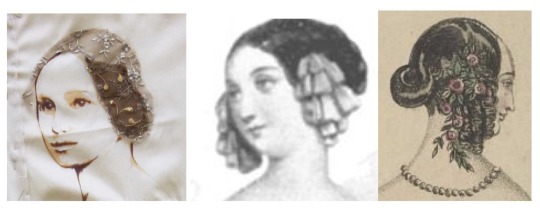
Ada’s coiffure, according to traditional hairdressing in London in the first part of the 18th century.
For the accessories Zambarbieri usually wanders through the narrow streets of Florence, like a “flaneuse” escaping from Walter Benjamin’s masterpiece “Arcades Project/Das Passagenwerk”, looking for artisans and small vintage shops, markets of antiquities and notions stores which seem to be cabinets of curiosities. In these mostly unknown and unexplored places the artist searches for precious buttons in different materials, covered by fabrics or pressed cloth, antique and contemporary lace and tulle, threads and ribbons, decorative ornaments of various periods.
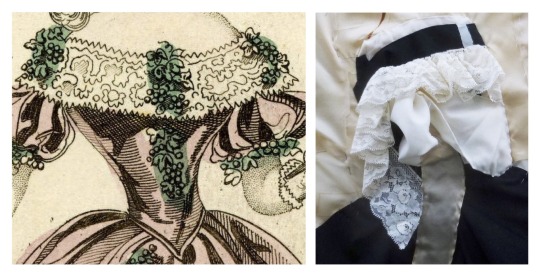
Instinctively she acted like this to create a tailored garment for Ada. The result was absolutely stunning. Zambarbieri’s creature is a new kind of Ada gifted with youth and beauty, which is not in contradiction with her brilliant mind, often overshadowed by Charles Babbage. Ada’s outfit is enriched by an ample handmade gown that hides the layers of petticoats, following the fashion guide of the initial years of the Victorian rule.

To conclude we can say that the project emanates a feeling of freshness and a sense that originality and even provocation are not only alive in the contemporary design of clothing, but also in the connection with the values of history. Ada revisited offers an invitation for women to dream, a respite to gaze at and appreciate intelligence paired with beauty and grace, and, most awesomely, an opportunity to think.
All this happened in the magic month of December 2020, only a short time before another fragment of “Women in Science” got lanced by Elisabeth Vermeer to be presented on February 11th 2021. American astronomer Henrietta Swan Leavitt is the pioneering protagonist of the next chapter of History and Slow Couture.
Stay with us.
0 notes
Text
Backstage of a flowery catwalk.
For the Italian translation click on the link.
Every beginning is like a promise. An ideal gift wrapped into a decorative paper. There is a vision at the horizon, a blooming picture full of magic in order to reach an important aim one is concerned about. I remember Lawrence Ferlinghetti’s wild dreams about a new beginning: “Eyes smell flowers and become them….” His poems accompanied me on my journeys and I still love to recite his verses, in a loud voice.

The Promise. Silvia Zambarbieri’s works rolled in. Entrance of the Garden Serre Torrigiani, Florence.
So it was with Silvia Zambarbieri and the difficult beginning of her textile exhibition in homage to English 18th century’s botanist Anna Atkins. What my alter ego and dearest friend, Curator Elisabeth Vermeer, had on her mind for the setting at the Serre Torrigiani in Florence, and not only there, was a scenography of giant flowers growing on the hedges, coming down from tree branches, lying on the meadows, hanging on the wall of the Greenhouse. When our fashion artist approached the venue for the first time, she brought a textile roll under her arm, tied with a ribbon in cotton. The roll hid the story of her most intimate garden. Nobody could imagine how it would end up. Again with Ferlinghetti’s words: “Lives cross lives.”

Silvia Zambarbieri, “Magnolia” patchwork in various materials with embroidered pistils put into evidence.
Elisabeth Vermeer divided the exhibition into various little gardens. The mission of the invited artists was a confrontation with nowadays nature and the consequences of the climate change on nature’s health. Silvia Zambarbieri’s objective was using the art of botany drawing of the past centuries and transforming the images into three dimensional works in textile fabric. Moreover, in her everyday life she actively stands up for the planets safeguard insisting on research, on the processing of natural materials and on the ecological sustainability of fashion design and of her own creations she makes a living with, bags, dresses, shirts, jackets and objects for the home.
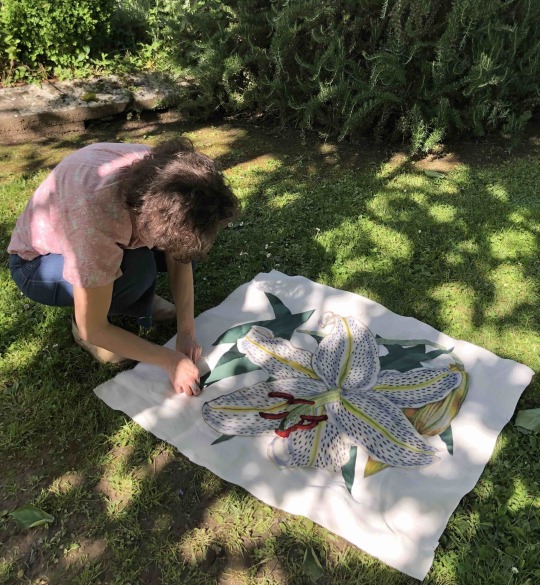
Silvia Zambarbieri fixes the giant lily’s green leaves on the cloth.

Another version of a Magnolia in the grass. Botanical illustration.
The calm atmosphere of a sunny lazy Saturday afternoon in May allowed the observation of the surrounding nature but also the recall of the memory of botanical illustration. Where does it come from ? Prior to the invention of photography, botanical illustration was the only way of visually recording the world’s many species of plant life. Artists and illustrators shared the beauty of botany with the world. Their work required great artistic skill, attention to fine detail, and technical horticultural knowledge. This is the point where we can reach out to botanist Anna Atkins who was the first woman to produce a photography book on her magnificent cyanotype impressions of algae, ferns, poppies, blades of grass, anatomised leaves.
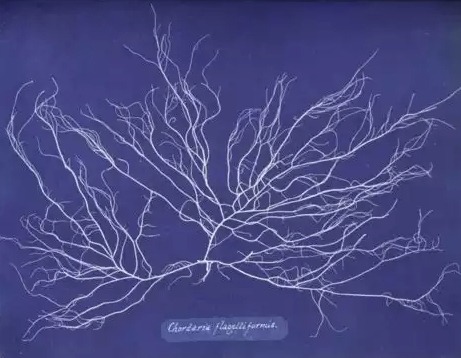
Anna Atkins, Cyanotype of Ocean Flowers
Silvia Zambarbieri pays homage to plant life in a contemporary way by studying the morphology and the gracious appearance of the plants. Beyond her favourite illustrator Pierre-Josephe Redouté there were many other extraordinary botany artists in the course of the last centuries like Maria Sibylla Merian, the Bauer Brothers, Anne Pratt, Marianne North, Ernst Haeckel, Rory McEven, Pandora Seelars, maybe one of the most important botanical artists of all time. At the moment Zambarbieri’s recurrent botanical subjects are lilies, waterlilies, irises, magnolia, roses and tulips.

Giant Lily set on framed paper. Wall of the Historical Greenhouse, Serre Torrigiani, Florence. Pierre-Joseph Redouté, etching of a lily.

Pattern of the Red Giant Lily lying in the grass. Pierre-Joseph Redouté, Fleur-de-Lys of Saint Jacques.
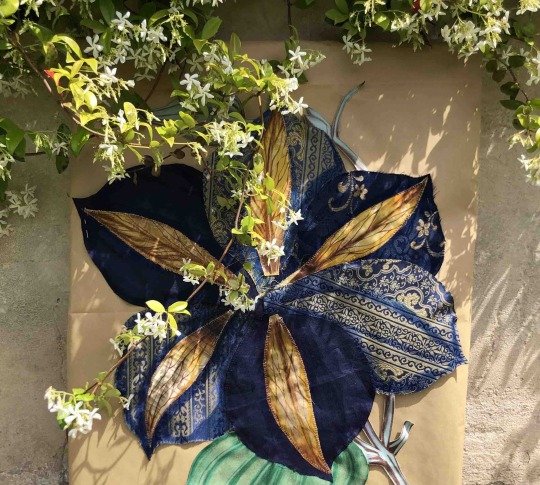
Blue Giant Lily created with various materials in Zambarbieri’s typical patchwork technique. Setting on framed paper. Wall of the Historical Greenhouse, Serre Torrigiani, May 2021.
Zambarbieri’s recent occupation is the eco-printing of authentic blossoms, petals and leaves on cloth to create natural impressions on her dresses. The aspect and the shape of the prints are enriched and completed by drawing, painting and embroidery. English poet Robert Graves writes “in the beginning was a word”. In curator Elisabeth Vermeer’s life “in the beginning was a flower, simple, as simple as it seemed.” This is what she tries to hand over to all her artists and above all to who works with the heritage of botany, like Silvia Zambarbieri.
0 notes
Text
Voices inside the Green
2021 is a remarkable year of anniversaries, remembering both brilliant and dramatic biographies in the field of arts from Caravaggio Michelangelo Merisi da Caravaggio and Albrecht Dürer to Joseph Beuys, in literature from Charles Baudelaire to Mikhail Lermontov and Aleksandr Blok, in science from astronomer Henrietta Swan Leavitt to botanist Anna Atkins.
As Calliope’s blog “Slow Couture” deals mostly with nature, vegetal elements, plants and trees, and how nature has always been intrinsically interlinked with fashion, let us talk about English botanist Anna Atkins and a beautiful project regarding her work, her positive impact on fashion, but also how contemporary artists confront themselves with the radical change from the image of an uncontaminated nature in the 18th century to the present effects of global warming.
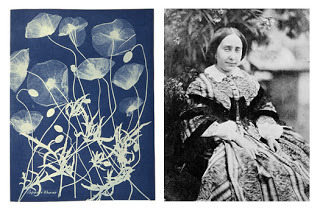
Anna Atkins and one of her cyanotype works, the Poppies.
Hundred fifty years after Anna Atkins’ death the fascination of her research has not changed ever since. She was the first woman to accomplish a book of photography in history. Orphan from her mother, Anna was grown up by her father who passed on to her his passion for scientific disciplines. Passionate of botany, Anna classified flowers, plants and algae, elaborating very detailed illustrations and etchings and dedicating herself to the building of very rich herbariums. Thanks to the famous scientist John Herschel, who was among the pioneers of photography, Anna discovered and explored the art of cyanotype by using two chemical substances, paper, water and obviously light so that she was able to block the image of an object forever and immortalize nature in a magnificent eternal blue. Obscured by history and her own modesty, Anna finally obtained her merited acknowledgement for the outstanding achievements in her research.

Anna Atkins, cyanotypes
In times of pandemic, nature is a relentless source of inspiration to cultivate one’s own creativity and the hunger for discoveries in the artistic and in the poetic field, due to the restrictions to organise exhibitions in indoor spaces. So Curator Elisabeth Vermeer suggested an outdoor exhibition project entitled “Voices inside the Green” that took place in May 2021 in one of the most enchanting gardens of Florence, the Serre Torrigiani. This is a perfect frame for the innovative setting up of the artworks in the labyrinth of the Garden in Italian Style. The innovative feature is based on the printing of the images of the artworks on waterproof canvas so that the surface of the hedges could be used for the exhibition lay-out. Instead of laborious transportation and the variety of works from painting to sculpture, from photography to drawings which could hardly been exhibited outside, the prints on canvas have all the same dimension and create surprising site specific geometries in the labyrinth.

Serre Torrigiani, Florence. An overview.
Thirty artists of diverse disciplines decided to participate in the project, from the field of visual arts to live performance, from poetry to theatre and music because the general topic linked with the problems of the planet suggested by the curator attracted their curiosity. The exhibition is not at all meant as a praise of uncontaminated nature and its beauty. On the contrary, it is a serious reflection on the unavoidable deterioration of nature as a result of a long process in which human beings have not assumed their responsibilities. Now the planet is in conflict with nature, facing global warming, air and water pollution, the reduction of the soil, acute drought, deforestation and similar natural disasters. An art video produced by Elisabeth Vermeer for the International Earth Day 2020 narrates the general situation with impressive images.

Wild fire consuming an Australian forest in early 2020.

The dangerous phenomenon of deforestation.
In the course of 2020 Design for Everyday Life frequently insisted on the menace of natural catastrophes like global warming, drought, the reduction of the soil through projects discussing the reasons for the precipitating situation. We talked about trees and the phenomenon of deforestation. We should also dedicate a particular observation to urban green areas and to the plants, considered the fact that thanks to their existence we respire and we nourish ourselves and therefore we are alive. Plants are fundamental for our lives and this is why the United Nations proclaimed 2020 the “Year of the Health of Plants”. In the project “Voices inside the Green” plants have a special role which is put into evidence by most of the artists, poets and contemporary musicians who have been in contact with nature, since their childhood, and who possess the conscience of the fact that the vegetal universe is inseparably connected with human civilisation. On the humanistic level we may consider the project as a conceptual continuation of last year’s “The Voices of the Water Lilies”.
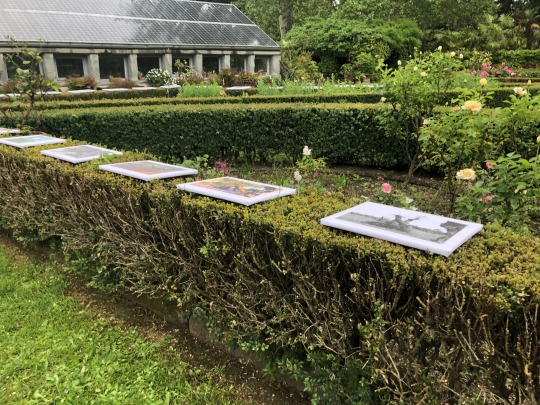
Serre Torrigiani, artworks on display in the Labyrinth of the Italian Stye Garden.

Serre Torrigiani, artworks on display from a different point of view in the Italian Stye Garden.
Art which acts against the menace of the disappearance of green areas in the cities, art which interacts with botany and biology and agriculture which respects the natural evolution of landscape, enjoys the dialogue with a Garden like Serre Torrigiani. Art is also a perfect instrument to commemorate important personalities through special case studies. So Claude Monet’s memory is reflected in a site specific installation of Veneto artist Francesco Geronazzo actually resident in Margaret River in Australia. His monotype entitled “Water Lily” engraved on transparencies, consists in a big number of elements in various dimensions and colour graduations immerged into the waters of a fountain. The floating land art installation varies its green shades from musk to olive and water plants. The big quantity of leaves shape a dense carpet of a waterlily nest, challenging the Water Garden of French Master Claude Monet in Giverny, hundred eighty years after his death.

Francesco Geronazzo, Natural Elements. Monotype on acetate, 2020/21. Fountain situated in the Italian Style Garden of Serre Torrigiani.
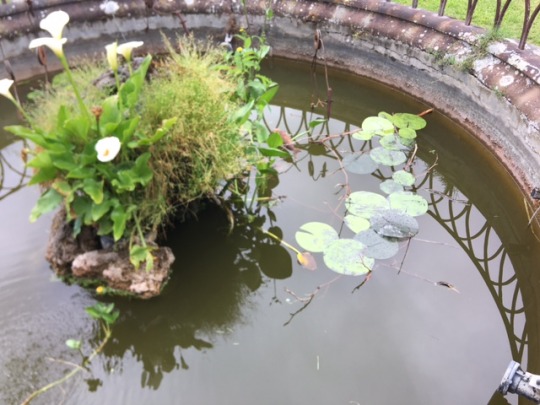
Francesco Geronazzo, Natural Elements, detail.
But Francesco Geronazzo uses his art for the service of a silent denounce which concerns Australian burning nature and all the other burning forests in the world, like in Brazil, California, Sicily. The climate change augmented the risk of the wild fires in the forests of about 30 %. Since October 2019 in Australia ten millions of acres have been devastated, 470 species of plants were extinguished and one milliard of wild animals was killed. Geronazzo grew up in a small town in the Veneto, surrounded by healthy nature and its vital colours. So he transformed the authentic images of destruction in Australia which he had in front of his eyes, with great sensibility in leaf skeletons engraved with pigments on textile fabric. His leaves cry for the long months of pain, still with the traces of the burning on the grains. After 240 days of fire the trees of eucalyptus sprouted new leaves. The ecosystem has changed and nature has shown resistance. We have got a chance. Geronazzo’s botanical tale like the complex narration of the exhibition “Voices inside the Green” hopefully opens a new page of ecological conscience.

Francesco Geronazzo, Natural Elements. Monotype with pigments on cloth. 2020. Historical Green House, Serre Torrigiani, Florence.
The conscience we referred to before, has also permeated the domain of fashion and handicraft. We could follow this development on the recent Parisian catwalks. And in the Florentine Garden we met once again talented Silvia Zambarbieri who presented a series of new giant flowers in mixed media, using embroidery, drawing and painting on big natural textiles like hemp, linen, cotton and canvas. A romantic cave, overgrown with vegetation, hosted her “Slow Couture “ works on the shadowy evergreen walls where she recalled the illustrations of French and English masters of botany drawing. Her flower repertory always embraces sensual species like iris, lilies, fleur-de-lis, but also majestic tulips and other floral fantasies.

Silvia Zambarbieri, Giant Blossom, 2021. Mixed media - drawing, painting, embroidery. Cave in the Italian Style Garden, Serre Torrigiani.
All the creations designed by Zambarbieri are exclusively sewn by hand. Based on a primary sketch, she chooses different materials, then she cuts the necessary dimensions, assembling the fragments to obtain the desired flower. In all her projects the big flashy pistils of the floral creatures are usually embroidered and put into evidence her passion of botany. In the Garden of the Serre Torrigiani Zambarbieri’s flowers assume an exotic character, like the flowers of a fairy tale bewitched by a magician. It seems they patiently wait for the liberating touch in order to get their human shape back. The artist conserves the beauty of nature in her works, with the strong belief that only beauty will render us better.
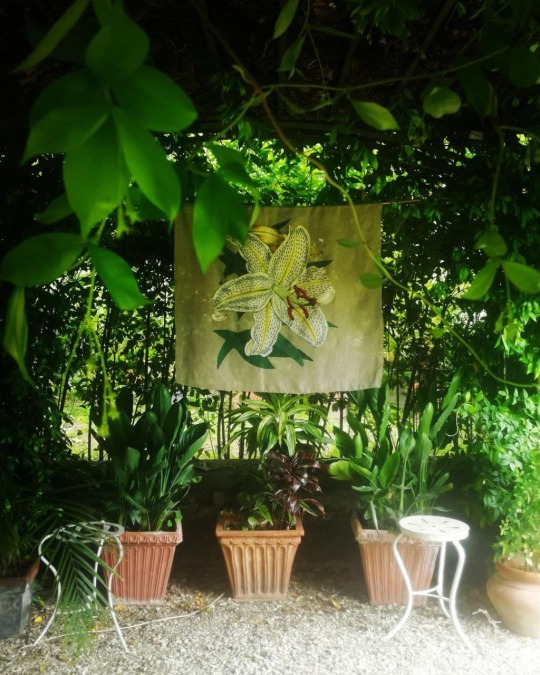
Silvia Zambarbieri, Giant Lily, 2021. Cave in the Garden.
In the Historical Greenhouse a small space of tropical plants Is a magnificent setting for two monumental tapestries hanging down from the ceiling. The protagonists are a red and a blue giant lily. Both works came into being during sleepless nights, without counting the infinite hours Silvia Zambarbieri spent on the production. The red lily dwells on the huge surface of a long water green chiffon. The flower itself is created by a patchwork of different shades of red to intensify the effects of light and shadow. The shapes of the leaves are made of diverse shades of green satin.
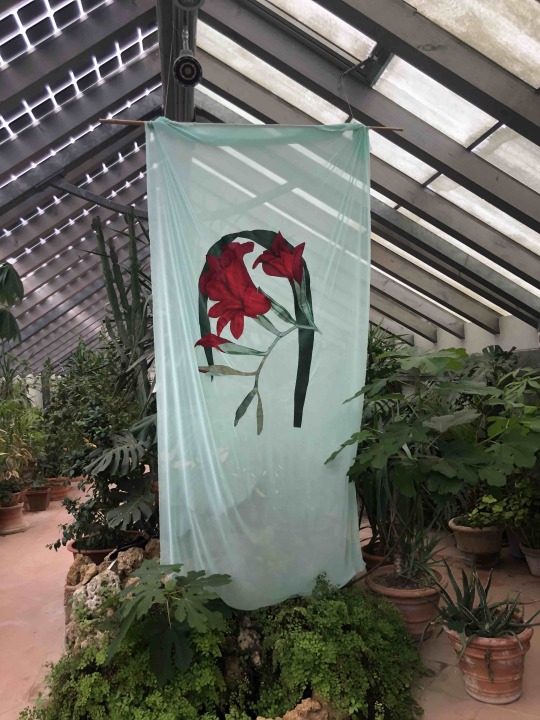
Silvia Zambarbieri, Red Giant Lily, 2021. Historical Green House, Serre Torrigiani.
Silvia Zambarabieri will appear again in the next chapter of “Slow Couture” dedicated to the Backstage at the Serre Torrigiani and to the interesting moments of how her works come into being and in particular in a site specific exhibition which is always original and never a copy of the previous one.
“Voices inside the Green” curated by Elisabeth Vermeer is planned as an itinerant exhibition. At the beginning of September the works will be showcased in a green venue near Viareggio, Tuscany. Later in autumn the exhibition will be hosted by the “Festival Europa in Versi” at Villa Gallia in Como in October 2021, in collaboration with the “Casa del Poeta.”
0 notes
Text
Stories of Limnades.
After Silvia Zambarbieri’s mise-en-scène in the Triangular Cloister of the Saint Augustin’s Museum in Genoa, she moved her floral requisites to Rome to be part of another exhibition adventure. In the splendid setting of the Botanical Garden Sapienza in Largo Cristina di Svezia in Rome, the artistic poetical project “Stories of Limnades” conceived and curated by Elisabeth Vermeer introduced the story of the Nymphs of the waters into the arts. The narration of the exhibition initiated metaphorically in their lair. Mircea Eliade writes on this purpose: “The nymphs were the divinities of all the flowing waters, of springs and sources. They were there at their place, from the beginning of the world; they obtained the human shape and their name probably from the Greeks.“

Charles François Jalabert, Nymphs listen to the songs of Orpheus. Oil on canvas, 1853.
The Limnades represent those inferior divinities that personify the aspect of stagnant waters. Nymphs determine the start of the cultural journey which rebuilds the temporal and the thematic axe departing from Claude Monet, Father of Impressionism, on the 180thanniversary of his birth, to join younger Boris Vian in the centenary of the birth, passing through the surrealistic universe of the cult novel “Froth on the Daydream”. In Elisabeth Vermeer’s projects dwell in a boundless universe, there are no temporal and spatial frontiers, according to Quantum Mechanics, in her cultural interdisciplinary perspective people of past dimensions meet up with the present and viceversa.

Claude Monet (1840/1926)

Boris Vian (1920/59) French polymath writer, actor, critic, translator, engineer, inventor and musician.
After its debut at the International Festival of Poetry “Parole Spalancate” 2020 in Genoa, the exhibition project dedicated to the pioneers of art and literature and to waterlilies, aquatic plants for excellence transformed into artworks, was hosted during the autumn months by the Museum Botanical Garden “Sapienza” of the University of Rome, the third venue of the itinerary, the third exhibition passage. The project coordinated by Design for Everyday Life reinforced the ancestral union between human beings and the water, by offering an important occasion to reflect on its importance for the entire ecosystem, beside the emotive invitation to return to nature, thanks to the interdisciplinary contributions of botany, contemporary art, history and mythology, poetry, music and their respective languages.
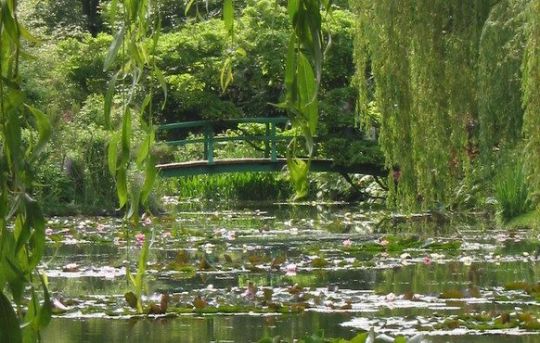
Monet’s Aquatic Garden in Giverny.
The varying landscape of the Botanical Garden, with its ponds, fountains and suggestive small lakes, represents an outstanding stage for innovative artistic interventions. Claude Monet’s memory emerges from a site specific environmental work showcased in the inferior pond of the Japanese Garden where sixty elements in acetate of various dimensions, created by Veneto artist Francesco Geronazzo, form a dense carpet of waterlily leaves and challenge the famous aquatic garden of the French master in Giverny.
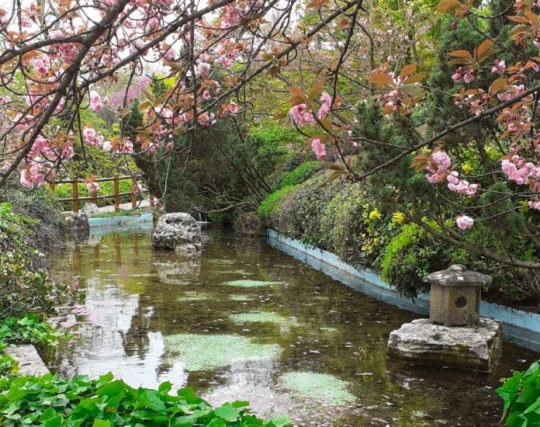
Japanese Garden in the Botanical Garden “Sapienza” of the University of Rome.

Francesco Geronazzo, Waterlilies, 2020, Monotype on acetate in various dimensions.
In another point of the Botanical Garden the cloudy waters of a pond, characterized by its aquatic vegetation, are a perfect place for the works of thirty three international artists, printed on sheets of acetate which fold and unfold like the leaves of a fold-out brochure in the wind. A surprising Land art-like composition generates an associative and transversal network of lectures and interpretations with a choral message of thirty three voices reminding us to stop and to rethink our relationship with nature. Artists are witnesses of their times and though art cannot change certain situations, it represents an essential instrument of communication with a very powerful evocative force.
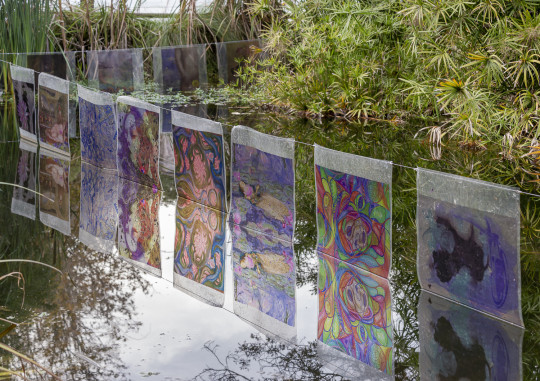
Waterlilies designed by artists Marilena Faraci, Uri De Beer, Enza Lomonaco, Mario Pepe, Françoise Morin, Joanne Morgan, Carlo Accerboni. Photo Credit Klara Varhely / Exhibition design Elisabeth Vermeer.
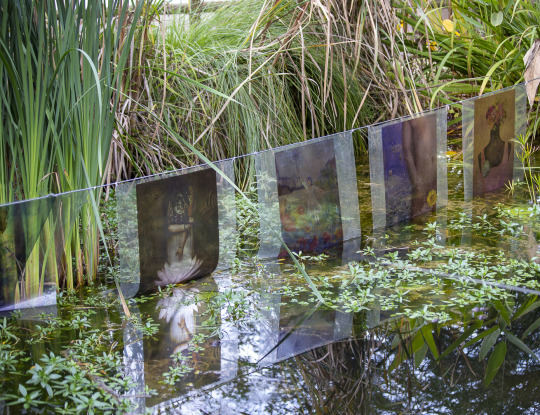
Waterlilies created by Silvia Bibbo, Fabrizio Cillo, Simona Campi, Farzaneh Rostami.
Among the artists we meet again artisan and designer Silvia Zambarbieri whose textile sculptures (under the brand D’Iside) were exhibited in flowerbeds, on bushes and trees, transferring the magic of waterlilies in blossom on natural and eco sustainable fabrics by means of embroidery and painting on cloth. Her dresses and bags were also showcased in the Big Greenhouse and in the Greenhouse “Corsini” of Succulent Plants. Her waterlily print was positioned on the external wall of the Green House together with other artists who portrayed and printed various plants like Maria Cristina Cincidda, Salvio Capuano, Erzsebet Palasti, Gian Luigi Suman, Maurizio Elettrico.
The Big Greenhouse, a historical venue built in 1877 by Mathian Di Leone is the stage of Silvia Zambarbieri’s textile objects in natural materials like linen and cotton, mixed with embroidery and painting.
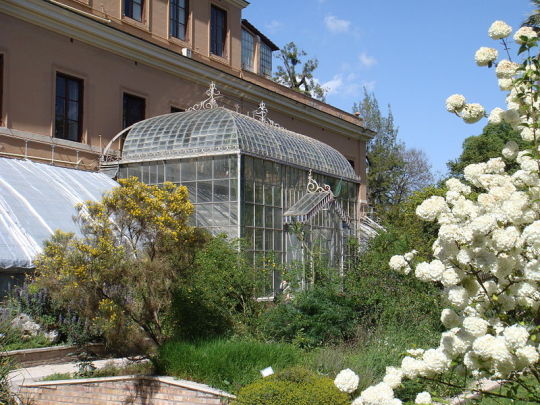
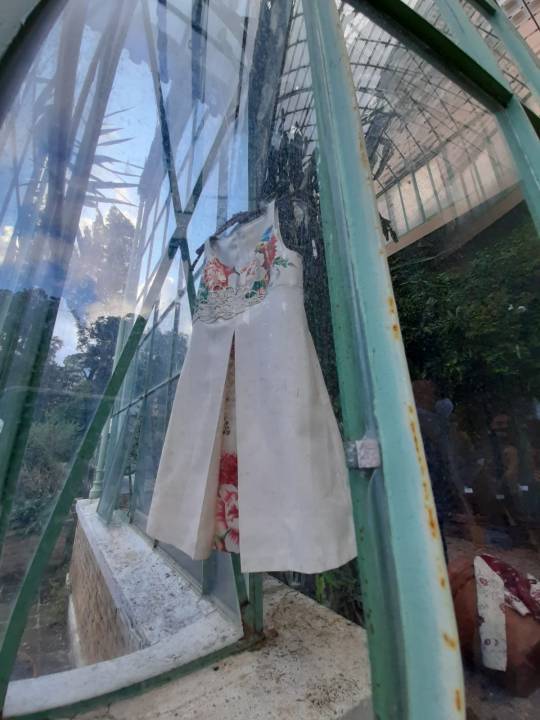
Silvia Zambarbieri, dress in satin, painted by hand with floral fantasies. On the top decorative applications of a flower created with cotton thread in traditional crochet technique.
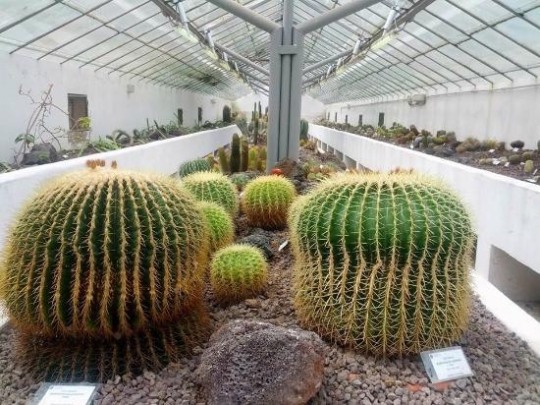
Green House “Corsini” of the Botanical Garden “Sapienza”, Rome, with the famous collection of succulent plants.
In front of the Green House Corsini, on the subtle branches of a climbing plant Silvia Zambarbieri presented a romantic bag in wool fabric mélange Bordeaux and according to her vintage style, decorated by crochet applications and and a jewelry bottone. The bag’s handle is made in a fantasy of gobelin fabric.
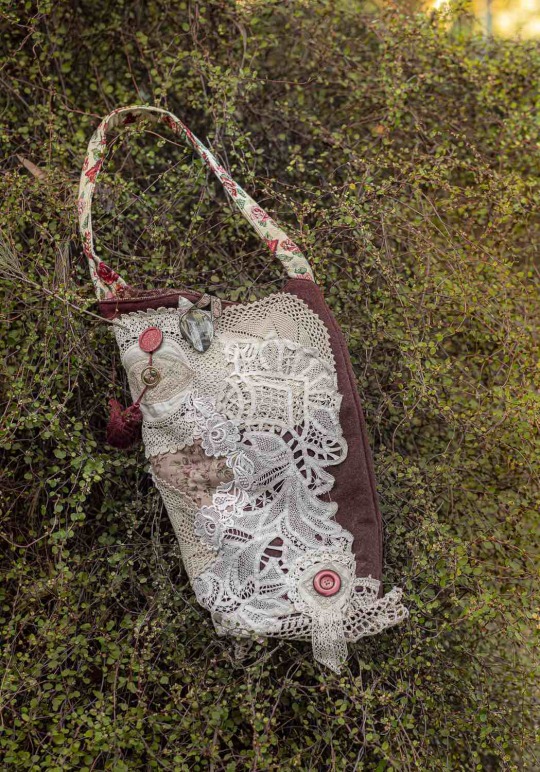
Silvia Zambarbieri Bag. Handmade pièce unique. Photo Credit Klara Varhely / Exhibition design Elisabeth Vermeer.

Silvia Zambarbieri, bag in raw cotton with an embroidered waterlily in big scale.

Silvia Zambarbieri, painting of lotus waterlilies on a white dress with vintage lace décolleté.

Silvia Zambarbieri, handmade painted dress showcased in the Greenhouse Corsini.
All the photos of Zambarbieri’s objects are made by Klara Varhely with Elisabeth Vermeer’s setting design.
The project patronized by the International Festival of Poetry Parole Spalancate in Genoa and produced by Design for Everyday Life, was organized in collaboration with the Museum Botanical Garden Sapienza. Moreover the project took advantage of the moral and organizational support of the Hungarian Academy in Rome; the Music Academy AIMART, Rome; the Cultural Association FotoPoesia, Genoa, ArteDisegno snc and Calliope Bureau Public Relations.
(Text by Elisabeth Vermeer, 2020/21)
2 notes
·
View notes
Text
Nostalgia of the Greeks and of the natural elements
Summer has always reminded me of the Greeks and of their concept of the light, a persuasive element in the entire Hellenistic scene. For Greek philosophers the sun as the "light of the world" represented mainly cosmic reason. Light embodies wisdom since it is through her that things are apparent. Greece is a country inhabited by light and by long lasting summers. When light floods into our life, in general, we enjoy it to a greater extent. Light is not only a source of aesthetic pleasure or environmental enjoyment by the subject, it has an existential impact on our physical and mental health.
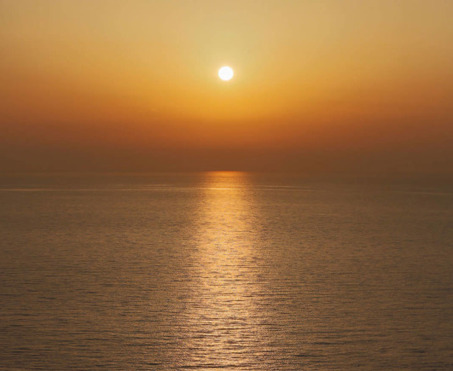
Ionian Sunset, detail ©Alexandros Maragos
Every year towards the end of September Europe celebrates the richness of cultural heritage with hundreds of events in fifty signatory member countries, under the motto: “Europe, a common heritage”. The annual program offers opportunities to visit buildings, monuments and sites, many of which are not normally accessible to the public. It aims to widen access and foster care for architectural and environmental heritage.

Ancient Acropolis of Athens, Unesco world heritage site.
Curator Elisabeth Vermeer chose a philosophical subject for her tribute to the European Heritage Days 2020, entitled “Nostalgia of the Greeks and of the natural elements”. The contents corresponded to the principle topic of the 26th Edition of the International Festival of Poetry “Parole Spalancate” of Genoa, whose Director Claudio Pozzani indicated the cardinal elements, water, fire, earth and air, in the centerstage of discussion. The ancient Greeks considered nostalgia a sickness, some sort of a medical condition akin to anxiety. Nevertheless nostalgic moments help us to put things in perspective, to realize where we come from and appreciate our past and learn from its mistakes, taking advantage of its experiences to fix the present and build the future. Recalling the Greek’s relationship with nature whose importance we can easily understand from Ancient Greek Poetry, art may stimulate deep reflections on our behaviour towards our environment and strengthen the interaction between culture, and ecological sustainability.

Greek Landscape
Given the spreading of the pandemic at the beginning of last autumn, the exhibition coordinated and produced by Design for Everyday Life, could not be set up in in the interior spaces of the historical venue, the Museum of Saint Augustine in Genoa which hosts Ligurian architecture fragments and sculpture from the 10th to the 18th century. So the artworks were showcased in its suggestive Medieval Cloister Yard which goes back to the 13th century. We are talking about an harmoniously arched Loggia erected on a triangular floor plan and determined by the regular geometry of the columns in stone and white marble with cubic capitals. The architectural quality of the venue is a prior feature in Elisabeth Vermeer’s work that is based on the coexistence and intersection with other disciplines, often dealing with science.
The opening of the event which was part of the agenda of the Italian Ministry of Culture MIBACT, took place on September 26th and 27th, 2020, in collaboration with the Museum and the City of Genoa, paired with a reading of poetry in the presence of Claudio Pozzani and Genoese poets Milena Buzzoni, Rosa Elisa Giangoia, and Marina Martinelli. Texts and poems proposed by the absent authors Marisa Tumicelli, Serena Vestene and Martina Mei were also recited.
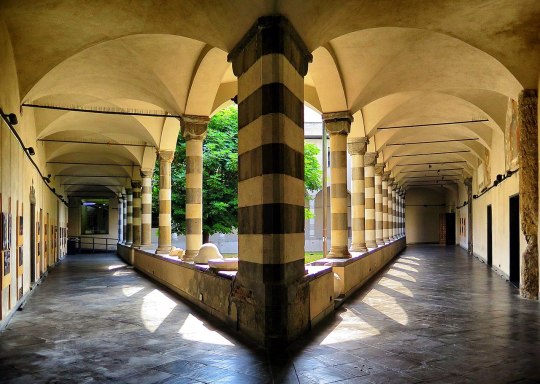
Cloister Yard, Museum of Saint Augustine, Genoa.
Curator Elisabeth Vermeer invited five Italian artists, Carlo Accerboni, D’Iside, Francesco Geronazzo, Mario Pepe and Alfredo Romano, to work on the cardinal elements, air and earth, water and fire, in relationship with the biggest enemies of the natural equilibrium: important pressing issues like climate change, air pollution and litter in the oceans, drought and deforestation. For the 50th Anniversary of the Earth Day in April 2020 Vermeer created a video work under the title “Reset the World” with the participation of fifteen international artists and a rich photographic documentation about the irreparable damages inflicted to nature and the ongoing destructive menaces nature is exposed to, all over the world.

Francesco Geronazzo, Natural Elements. Monotype with pigments on cloth, 2020. Artwork in reference to the Australian wildfires and their devastating consequences in the forests.
Designer Silvia Zambarbieri, under her brand name “D’Iside”, was absolutely in her element when she addressed herself to the mission of creating an inspiring outdoor scenery with textile sculptures and some objects. Her project area was around the majestic fig tree which dominates the triangular meadow confined by stone walls. Though its leaves were on the point of fading, the tree still showed a very thick dark green crown. The artist installed her works between the branches of the tree and at its bottom.
Like Italian artist Francesco Geronazzo actually based in Australia, Zambarbieri worked on the element of the water, interpreting a special plant living in the ponds, the water lily, favourite subject of Impressionist painter Claude Monet whose 180th anniversary of birth we already celebrated in several projects in the course of 2020. Both, Zambarbieri and Geronazzo, deepen in different ways, methods and materials, the ideal and artistic perspective of the waterlilies, evoking the urgency to find an ecological balance for a sustainable future in all the domains of the economy.
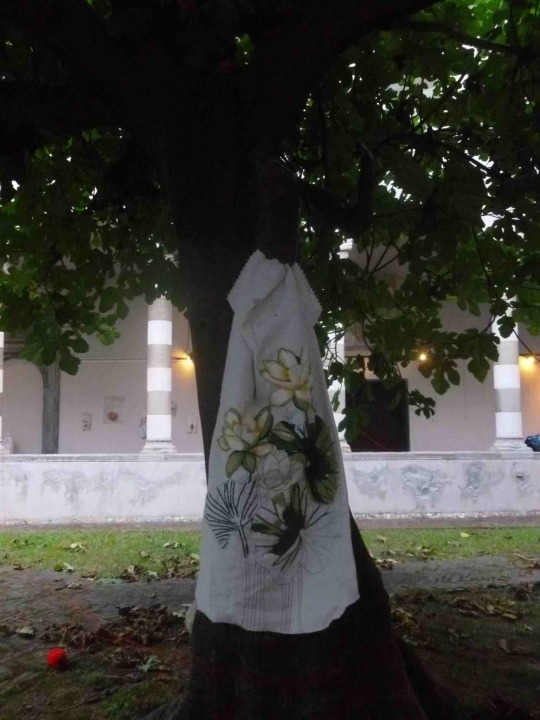
D'Iside, Waterlilies. Embroidery art work on old linen, work in progress showcased on the fig’s trunk in the Triangular Cloister of the Museum, September 2020.
According to her ecological policy, Zambarbieri proposes sculptural objects created in natural materials like hemp and linen of past times that conserve the authentic traces of the stories from real life. Taking into consideration that fashion is one of the most polluting domains, it is Zambarbieri’s must to respect nature and this is why she frequently brings the world of botany back to textile materials, taking inspiration from historical botany books and from the vegetal universe. For the exhibit in Genoa she invented a beautiful textile “fairy tale” elaborated with painted and embroidered water lilies on cloth.
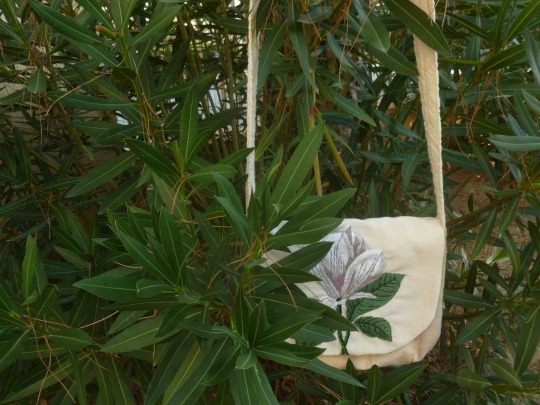
D’Iside, Bag in raw cotton and waterlily embroidery with wool thread 2020.
The amazing beauty of Zambarbieri’s fabric is the mixture of techniques she masterly applies according to the imagery she desires to bring into being, and the knowledge she gathers by studying the morphology of the plants in historical botany albums of past centuries and the evolution of the plants in the course of time. What apparently seems to be a dress softly falling down from the branch of a tree, is meant to be a sculpted textile object and a piece of art.
D’Iside, dress with painted water lilies. Museum of Saint Augustine, 2020.
Silvia Zambarbieri spent a long time on portraying flowers on paper and cloth, roses, tulips, hyacinths and especially water lilies. There are around sixty species of waterlilies throughout many parts of the world, in both temperate and tropical climates, and they come in lots of different colors, shapes and sizes. The preferred habitat of these aquatic plants is slightly acidic to basic water of lakes, slow-moving streams and pools. When they bloom, the variety of their colorful and fragrant flowers is exuberant and joyful. But unfortunately they only live for around four days.
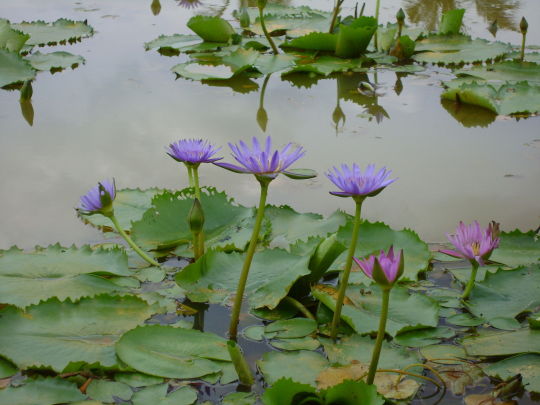
South Vietnam’s Water Lily
This is one more reason why the artist immerses herself into the world of botanic illustration and saves the memory of the short lived plants by transferring their portraits on cloth. Accurate observation and recognition help her to recreate the texture and structural elements of plants. Drawing is seeing. but what makes her work so artful is the fact how she manages to reproduce the plant’s remarkable lifelike detail as if they were natural inhabitants in a garden made of canvas.

D’Iside, handmade dress with painting of water lilies, hanging from a branch of the fig tree. Museum of Saint Augustine, 2020.

Water Lily Embroidery on hemp showcased on the wooden entrance portal of the Cloister Yard, 2020. (Photo credit : Carlo Accerboni)

Waterlily Embroidery with wool thread on hemp canvas treated with bitumen, 2020. Setting at the bottom of the fig tree with its imposing roots in the Cloister Yard of Saint Augustine.
After her short appearance in Genoa during the European Heritage Days, Zambarbieri participated in Elisabeth Vermeer’s project “Stories of Limnades. From Monet to Vian” at the Museum Botanical Garden Sapienza, Rome, at the end of October 2020. But this will be the contents of the next story. Stay with Calliope, keep in touch!
0 notes
Text
Glace-à-porter
After a long interval I happened to come across the young textile designer in Florence who I had met in spring and whose extraordinary talent paired with determination and courage merits to get widely introduced. I dropped into Silvia Zambarbieri’s Atelier after a kind of “poetic caesura” last July when a long and very hot summer took hostage of Florence.
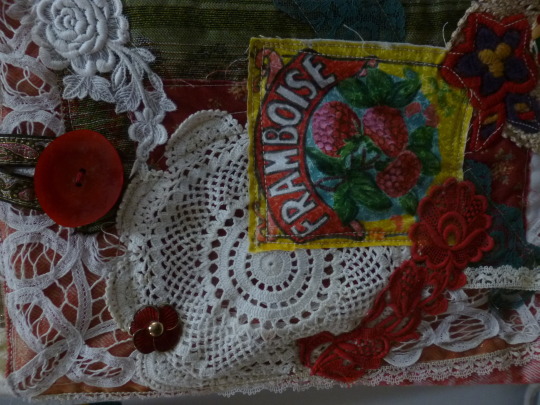
D’Iside Bag - collage of lace, embroidery, crochet and buttons, 2019.
Summer is inseparably connected with ice cream and sorbets which are a quintessential part of the season but it may come as a surprise to some that semi-frozen desserts were being enjoyed in certain areas of Europe over 300 years ago. Following to culinary history Marco Polo brought back the notion of water ices and frozen confections in the thirteenth century when he returned to Venice from his trip to China. Others say that Cathérine de Medici introduced it to France when she relocated to marry King Henry II. Neither tale is likely to be true, it is difficult to say whether water ices were first made in Italy, France or Spain. Italians were masters in developing methods of chilling and freezing drinks into sorbets and granitas. There is a special place, the Gelato Museum Carpigiani near Bologna, Italy, dedicated to the history, the culture, and the technology of ice cream made by craftsmen, a precious heritage passed over in the course of centuries.

Gelato Museum Fondazione Carpigiani, Anzola Emilia (Bologna)
The 17th century saw ice drinks being made into frozen desserts. With the addition of sugar, the more commonly known “sorbet” was created. In 1686, Francesco Procopio dei Coltelli, of Sicilian origin, opened the first café, Le Procope, in Paris. The establishment became a meeting place for many famous intellectuals and ice cream lovers, including Benjamin Franklin, Diderot, Balzac,Victor Hugo and Napoleon. The café introduced gelato, the Italian version of sorbet, to the French public. In England the first known recipe for dairy based ice cream was discovered in the diary of Lady Anne Fanshawe, an English biographer, who in 1668 named her recipe “Icy cream”, a mixture of an astonishing number of ingredients such as orange blossom water, mace and ambergris. But do you know the flavors of ice cream at Jane Austen’s times?

Lavender Earl Grey ice cream sandwiches à la Jane Austen
Driven by the thirst for transversal knowledge which unites international history with Italian present, artist and artisan Silvia Zambarbieri, under her brand name “D’Iside” began her research in the field of ice cream production last summer for a special project created by Design for Everyday Life and curated by Elisabeth Vermeer. “Ice Cream Poetry” is a project for poets and artists inspired by ice-cream to join an international community of ice cream lovers that exhibit their poems and artworks in our topic focused exhibitions. As usual, also in this case, Zambarbieri looked up history books, archives, made plenty of sketches and drawings of ice cream cones and sundaes and transformed these later into embroidery and patchwork patterns in small scale on cloth.

D’Iside Bag Collage of several materials, lace, crochet, eyelet and buttons, 2019.
She planned a totally inedited series of objects dedicated to ice-cream entitled “Glace-à-porter”, a play on words conceived by Elisabeth Vermeer who is a convinced promoter of Zambarbieri’s art and fashion design. The objects represent colorful and witty mini-bags with a certain capacity of hosting small necessities like a wallet and a mobile phone. Each bag is a unique piece, exclusively handmade and signed by D’Iside. The materials she uses for her collection range from bouclé yarns to jacquard, from cotton sateen to fresco wool. The bag itself is embellished with an appliqué under the shape of an opulent ice cream cone or a sundae. Mostly her “Glace-à-porter” bags reveal a reference to a drawing or a painting by American artist Wayne Thiebaud, born in Arizona in 1920.
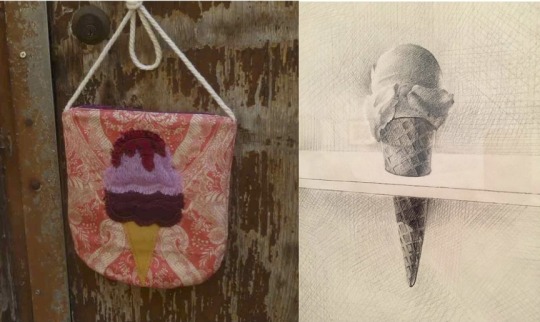
D’Iside Bag in jacquard fantasy. Shoulder strip in rough drawstring. Ice cream cone patchwork of different materials like wool, bouclé, jacquard, 2020.
Wayne Thiebaud, Ice Cream Cone, 1964.
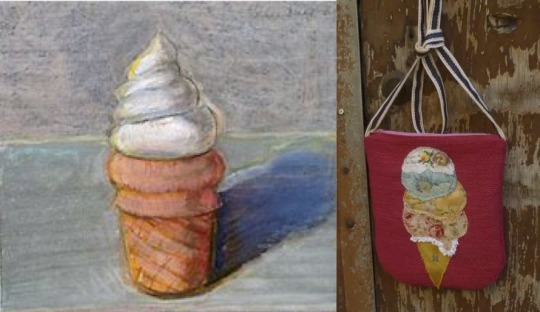
Wayne Thiebaud, Ice cream Painting.
D’Iside Bag in cotton. Shoulder strip in rough drawstring. Ice cream cone patchwork in various materials like cotton “fantasy”, and vintage tablecloth, 2020.

D’Iside Bag in cotton satin. Shoulder strap in cotton and linen drawstring. Wafer pod: patchwork of several cotton pieces “fantasy”, 2020.
Wayne Thiebaud Sundae.

Painting by Wayne Thiebaud, Museum Voorlinden, Wassenaar.
D’Iside Bag in Fresco wool. Shoulder strap in rough drawstring. Ice cream sundae: application of various materials like cotton, bouclé, jacquard, 2020.
On the occasion of the hundredth anniversary of Thiebaud’s birth it is a pleasure to remember his unmistakable heavy pigments and exaggerated colors and the well-defined shadows. The Museum Voorlinden was the first European museum to organize an exhibition around the artist. Famous for his mouthwatering depictions of cakes, ice creams and hot dogs, Thiebaud has placed the American everyday life at the core of his artistic practice. On the other hand, in the framework of fashion design, Silvia Zambarbieri, excellent observer of human attitudes in various fields and of the evolution of fashion as a telltale way of expressing ourselves, manifests the intelligent strategy to apply her utmost refined tailoring skills in beautiful but practical objects for everyday life.
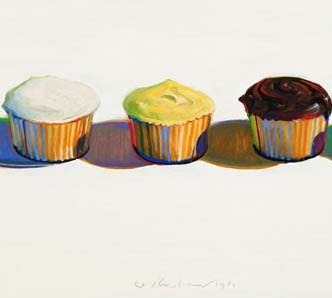
In the end of our travel through the history of ice cream and its translation into contemporary design thanks to Silvia Zambarbieri, we return to the importance of light in textile design and in painting, in memory of artist Wayne Thiebaud who wrote: “In the shadow all the light happens.”
Postscriptum: if you are interested to be part of our ice-cream project, send your poems or the photos of your artworks to the address [email protected].
#wayne thiebaud#designforeverydaylife#diside#florentine artisans#ice-cream and poetry#ice-cream history#made in italy#gelato museum#slow couture#parole spalancate
1 note
·
View note
Text
Slow Couture

One day in early March, when strolling through the historical center of Florence, I dropped into a very small atelier, characterized by a shop window with a beautiful handbag. It did not take a long time and I fell in love with this charming handmade object, as it reminded me of a luxurious atmosphere when clothing and accessories reflected the place and culture of the people wearing them. My childhood, gone with the wind. I got nostalgic and opened the door to make friends with a young lovely woman from Milan, creator of a fashion brand which is a surprising example of slow couture. D’Iside is a synonym for high quality accessories, unique handmade pieces, and dresses, blouses and skirts for ladies and children in natural sustainable materials like hemp and linen.
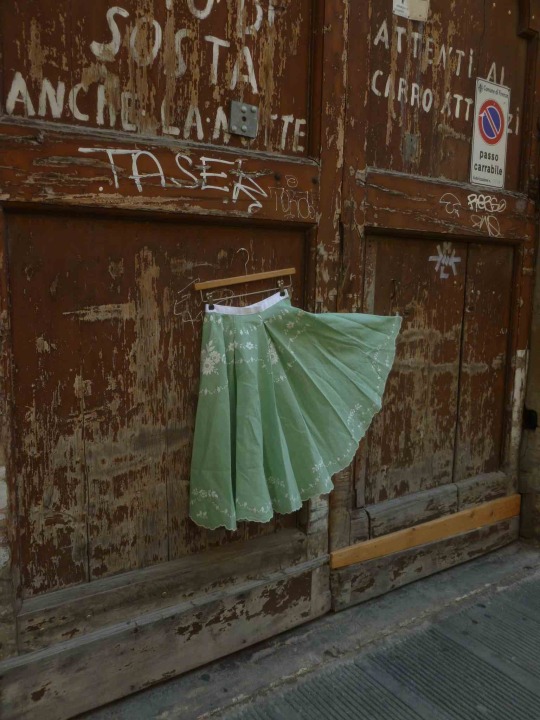
You may say there are so many fashion designers right now in all the parts of the world that produce locally sourced, ecologically oriented garments, where is the difference? Well, it is the way how Silvia Zambarbieri conceives her objects and the relationship she develops, every single time, with the material she chooses. She is a researcher, she has no hurry when looking for the suitable material, moving from one antique shop and market to the other until she discovers a piece of lace, an embroidered collar, a crocheted tablecloth, a priest’s tunic or a particular fabric covered button.
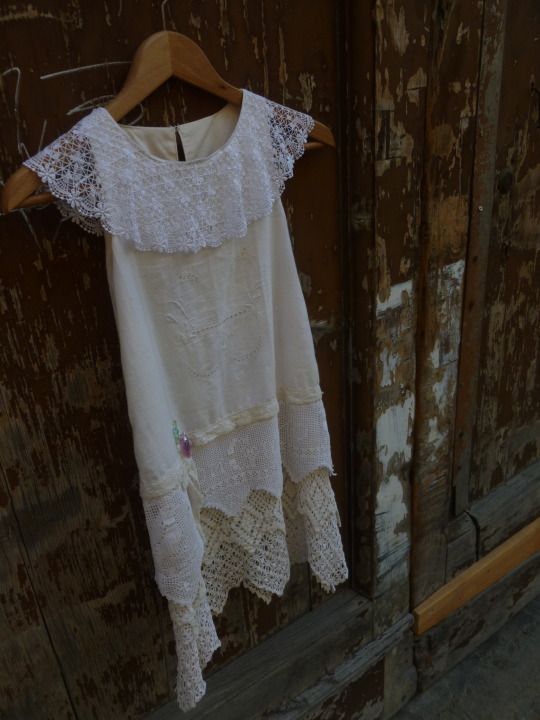
Frequently she deconstructs the original fabric and recomposes several fragments of different provenience to shape a new gown, a new object. Beside the formal silhouette, Zambarbieri applies mixed media to obtain the final aesthetical aspect she desires. Intense studies of botany, the drawings of flowers, leaves and plants, led her to mingle both, embroidery and painting, on cloth in order to create enchanting flowerbeds “en miniature,” waterlilies, roses, camellias on geometrically shaped light colored dresses with a fanciful application in lace.

Zambarbieri based her creations on an ethical foundation, sticking to fair practices for their environmental impacts. Her commitment as a designer means to respect nature and all the goods and benefits deriving from earth.
Beside her daily manufacture she also designs artworks for exhibitions. Recently she participated in Elisabeth Vermeer’s site specific group installation “The Waterlily’s Voices. From Monet to Vian” dedicated to the centenary of Boris Vian’s birth, on the occasion of the International Festival of Poetry in Genoa. The designer proposed the embroidery of a waterlily executed with wool thread on a hemp canvas treated with bitumen.
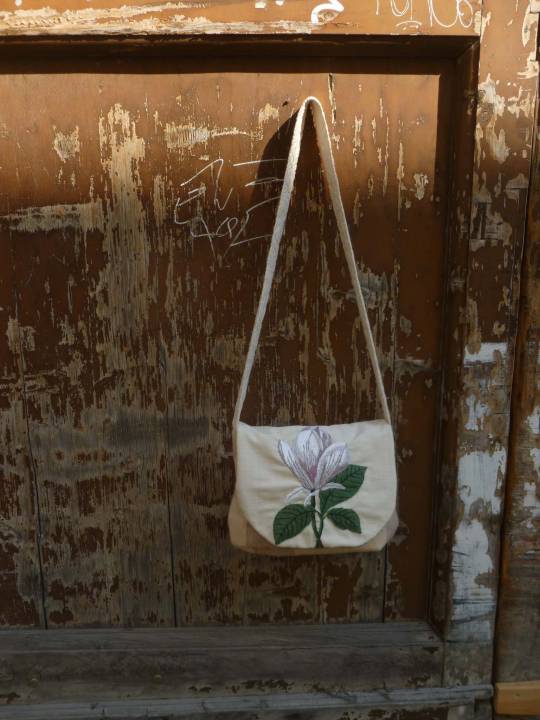
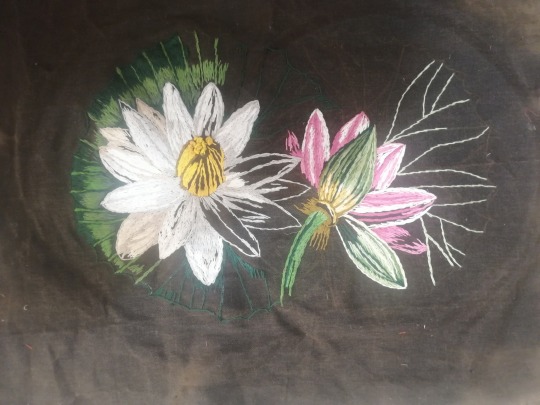
The Waterlily Embroidery with wool thread, 2020.
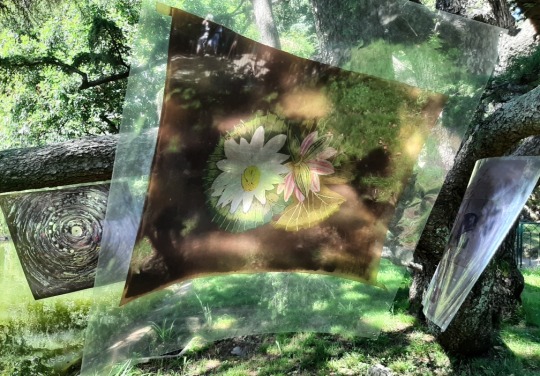
Print of the embroidery work on transparent acetate, suspended on a branch in the Park of Villa Pallavicini, Pegli, Genoa, in the group exhibition “The Waterlily’s Voices. From Monet to Vian”, curated by Elisabeth Vermeer, July 2020.
1 note
·
View note